The best way to sharpen your pencil?
It is important to sharpen your pencil to a good point if you wish to do a decent job when creating coloured pencil artwork. A coloured pencil is no use unless it is sharp.
Too many beginners keep working with a blunt pencil and wonder why they don't get good results. When asked "how do you sharpen your pencil" they give a blank look as if being asked a silly question. But there are actually a considerable number of options when it comes to getting a point on your pencil. And it isn't always the most expensive solution that gives the best results.
- A simple craft knife, with a metal or ceramic blade* will not only allow you to sharpen pencils but is also useful for scratching out pigment from the paper surface for whiskers or tiny hairs. (* As an Amazon Associate, I earn a small commission from qualifying purchases. The price you pay does not increase.)
- A small, handheld sharpener has the benefit of not taking up much room when you are working in a cramped or outdoor location.
- Sharpeners with a handle and a spiral cutter are not expensive and work very well, if a little more bulky to carry around.
- Electric pencil sharpeners are quick and easy, but need a socket so are mainly reserved for the studio. The battery version tend to be expensive to run.
Let's look at these options in more depth.
Coloured pencils produce a build up of wax or oil in the cutters. This can cause a jam. Running a graphite pencil through the sharpener will clean and lubricate the cutters.
Types of sharpeners
The low cost way to sharpen your pencil
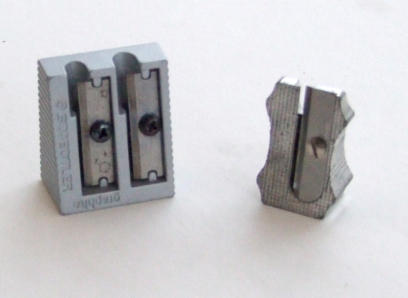 Simple bladed sharpener
Simple bladed sharpenerThe simple hand held blade sharpeners are excellent when they are new. There is a case to be made for buying a box full at 15 pence each and throwing them away as they start to become blunt. You can tell when this happens as they tend to tear the pencil wood rather than slicing it cleanly. The core pigment also tends to break as it is stressed by the old edge of the blade.
Some sharpeners of this type are disguised by being tucked inside a container that holds the shavings until you empty them, but the blade inside is the same. With these you are paying extra for the convenience of not having loose shavings to clean up.
Some metal sharpeners have two or more holes for different sized pencils.
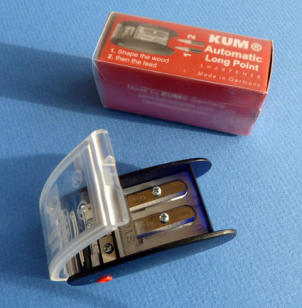 Kum long point sharpener
Kum long point sharpenerI like the Kum Longpoint (affiliate link) from Germany. This has two holes but they are both used to sharpen the same pencil. First you use the one on the left to shave the wood and expose the pencil core. Then the right hand hole is used to point the exposed core. A long sharp point is possible using these. You can also just sharpen up the point without removing further wood to repoint the pencil regularly.
(* As an Amazon Associate, I earn a small commission from qualifying purchases. The price you pay does not increase.)
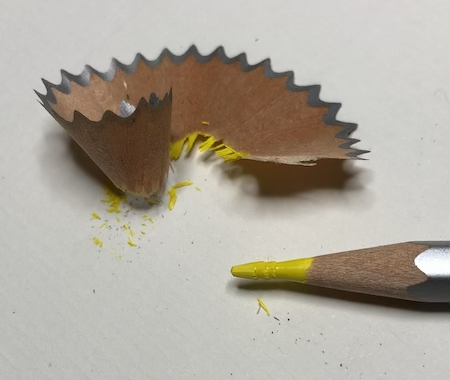 Kum longpoint left hole - sharpens wood
Kum longpoint left hole - sharpens wood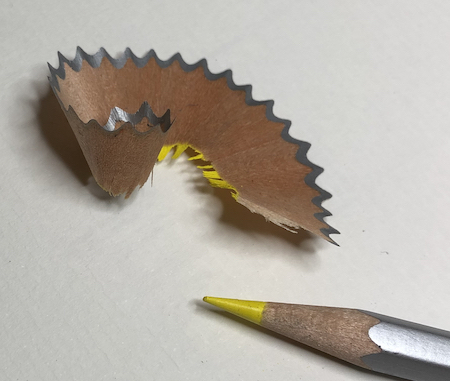 Kum longpoint right hole - sharpens core
Kum longpoint right hole - sharpens coreHand cranked pencil sharpeners
This type contains a helical cutter, with a handle that turns it. The pencil is held by jaws and the cutter revolves around the pencil as you turn the handle. They are economical, need no batteries and have a drawer to hold the shavings so you can sharpen multiple pencils at a time. You may recognise them from your school days?
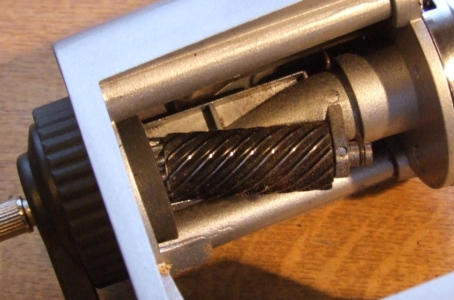 Hand cranked sharpener with helical cutter
Hand cranked sharpener with helical cutterThey are often sold with a clamp, with which you can attach them to your drawing table so they don't move about when you use them.
Many produce a fairly sharp, short point, and are more suitable for softer pencil brands like Prismacolor, Luminance, Coloursoft etc. which will break if you put pressure on a longer point.
Others have a screw that you can adjust to vary the type of point you can get with them. In some cases you can choose from blunt or pointed.
The jaws can hold pencils of different widths, but do make sure that your thickest barrelled pencils will fit before buying one.
The prices charged can vary quite considerably, with the more expensive offering replacement spiral cutters, although they are not always easy to find.
An economical option would be the Helix, available from Amazon*, which offers 5 different point lengths. I leave mine set to the longest point almost all the time, especially when using the medium to hard pencils, such as Faber Castell Polychromos and the Artist/Studio range of Derwent pencils.
Another recommended model is the Derwent Superpoint* manual sharpener. This smaller version has a plastic case and is lightweight, but there is also a heavier metal version. They both produce a lovely long sharp point, as would be expected from their name. Such points do need care in use and are best suited to the harder pencils.
For best results with these sharpeners be sure not to pull the front out fully. If you do, a metal bar with lock it, and the front will not go all the way back when your sharpen your pencil.
(* As an Amazon Associate, I earn a small commission from qualifying purchases. The price you pay does not increase.)
Battery driven sharpeners
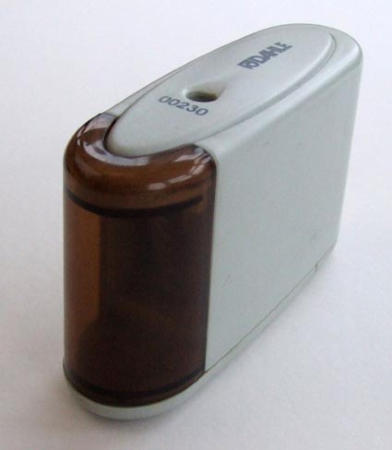 RoDahle oval battery sharpener
RoDahle oval battery sharpenerBattery drive sharpeners are convenient, but tend to be noisy and certainly expensive to run. They come into their own if you stray away from mains electricity.
The one illustrated above is the RoDahle oval battery machine which is sold under a variety of names and brands (including Swordfish) and is a Chinese import.
Whilst these are excellent when new, the motor tends to be only suitable for light use and tends to burn out if used for frequent sharpening.
They are expensive on batteries unless you find one with a mains adapter or use re-chargable batteries. Prices at time of writing were around £25.
Some machines now offer twin sized pencil sharpening.
Mains powered models
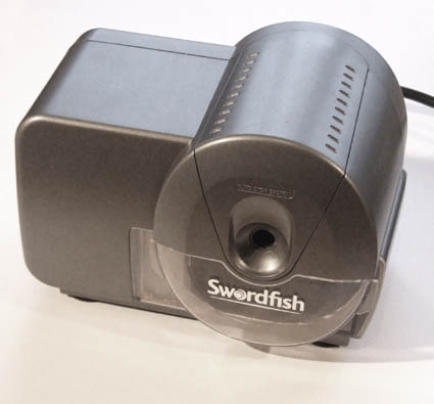
If you always work in one place, a mains powered model might offer the best way to sharpen your pencil. You can do this one handed, in a fraction of the time of sharpening by hand.
Once again look for a helical system for the best results. Swordfish, Jaker, (affiliate links) and Dahle all make very good machines.
Some have a selection of different diameter holes and others will alter the settings with the flick of a switch.
The Swordfish mains model 40050 , pictured above, is very strongly built and has an auto stop to save your pencils being over sharpened. Peter tried this model but found the cut-out which operates if the sharpener gets warm through use was a problem. The manufacturers warn it can take time to reset after 20 minutes of continuous use.
Most power sharpeners are sold for graphite use 'only', as graphite lubricates the mechanism and wax seizes it up. The solution is to run a graphite pencil through the machine from time to time to clean and "oil" it.
(* As an Amazon Associate, I earn a small commission from qualifying purchases. The price you pay does not increase.)
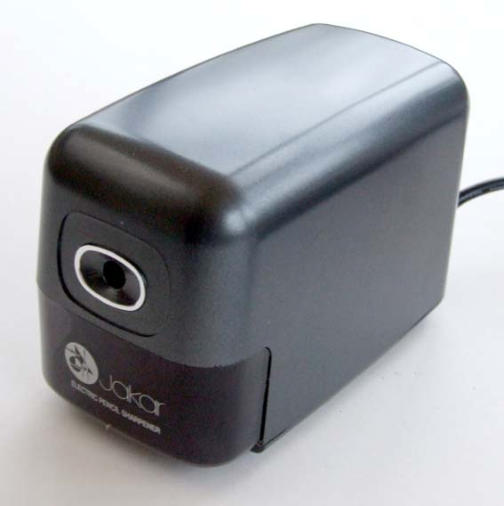
The next powered machine illustrated it from UK Art Materials supplier, Jaker, who have the machines manufactured overseas and branded to their name. The current models are both sold as suitable for coloured pencil use.
The mains model Jakar 5151 is very solidly built and has lasted well for Peter for four years. It sharpens efficiently and replacement spiral cutters can be obtained over the Internet. Not cheap, at between £30 and £40 but it is proving to be a long runner. He calls it his 'STAR' Machine.
The best sharpener for soft pencils
A reader has asked about the best sharpener for use with softer brands of pencil (like Derwent's Coloursoft or Prismacolor).
- Derwent Coloursoft are just under 8mm thick, whereas most are 7.5mm. Most cheaper brands of sharpener won't take these thicker penicils. Prismacolor are thinner and don't have this problem.
- Soft pencils will break more easily if sharpened to a fine point,
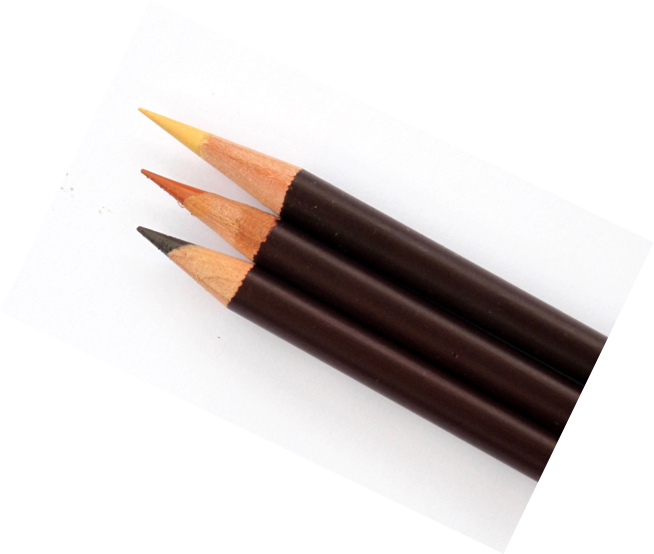
These three Coloursoft pencils have been sharpened in three different helical sharpeners.
- The top (finest) point is from the Jakar Mains Electric desktop model 5151. A superb point that will break off almost instantly any pressure is applied. This point will be quite stable in a harder pencil like Polychromos or Pablo etc, but is only suitable for very light and delicate work with Coloursoft. Once the tip has gone, however, the point is stable and great to use.
- The second sample (in the middle) is from the Jakar manual machine (5160). A shorter point and a more robust one for a soft pencil. As less core is visible, the pencil will need sharpening more often.
- The third (lower) example is from the low cost Lidl helical sharpener. A very much more robust point but not a long lasting one.The sharpener is, however very much cheaper than the others.
Average working length of core available ( tip to wood )
- Top approx 12 mm
- Centre approx 10 mm
- Bottom approx 8 mm
Note the cheaper sharpeners are not so accurate in cutting the pencil centrally, so the available colour strip is sometimes cut off centre and not therefore always uniform in length.
Using a knife to sharpen your pencil
The alternative to pencil sharpeners is to use a knife with a replaceable blade. There are several brands on the market.
The knife usually gets used for sharpening watercolour pencils, where I may well need to use the pigment for making up washes of colour for underpainting.
Let's look at how to sharpen your pencil with a knife.
A knife needs to be sharp and you need to use it with care and under control. You will see below how I use my thumb to control the exact pressure on the pencil point with the knife blade. Sharp blades are essential. More injuries occur from blunt knives than you would think. I always use a knife with a replaceable blade - and one that can be renewed easily.
I show a selection of cheap knives below. Most have a break-off blade that can be advanced from the holder, one is a cheap throw away knife and one is made by Olfa and has a small pointed blade inserted and locked into position. This last knife is the one I use most and can also be used for working colour on paper by scratching the pigment away as the cutting edge is on the slant ( most cheap knives have blades that cut in line with the handle).
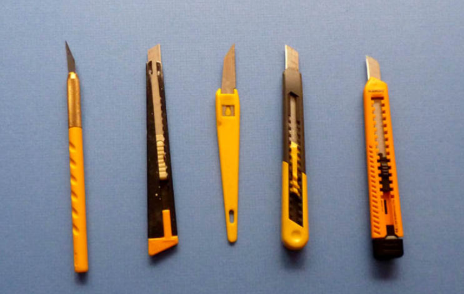
That is the OLFA knife on the extreme left.
The technique I show for sharpening is the method that I use. There may be other techniques, but I can only demonstrate the way I do it.
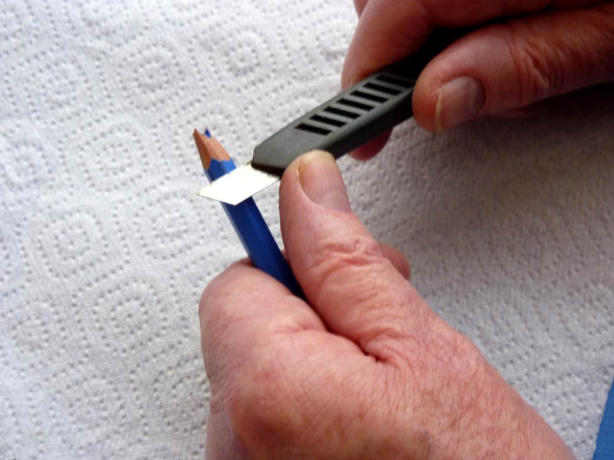
Taking knife and pencil and holding it over a surface or container to take the pigment and wood shavings, I start by holding the knife handle quite loosely in my right hand and control pressure and movement with my left thumb.
The pencil is also held firmly, and the cut is taken from a little way back down the pencil barrel in an upward curve so that the knife is almost parallel with the point as it leaves the pencil tip.
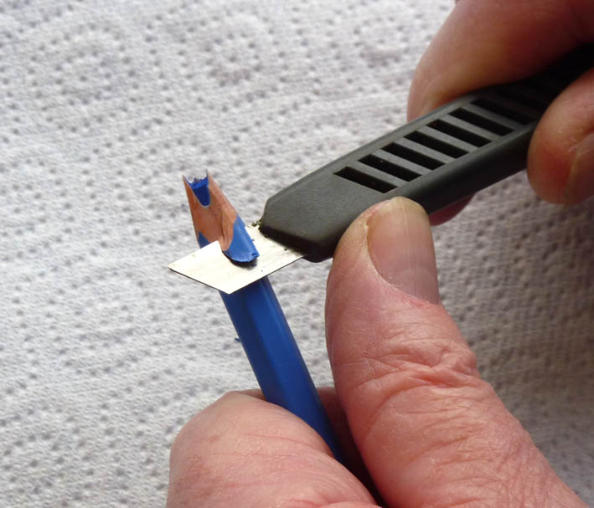
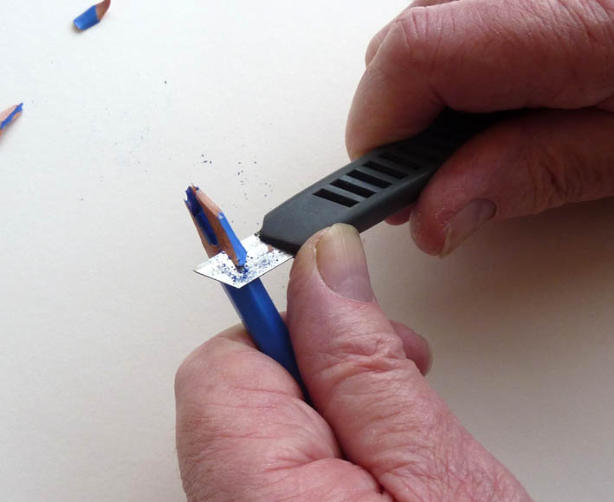
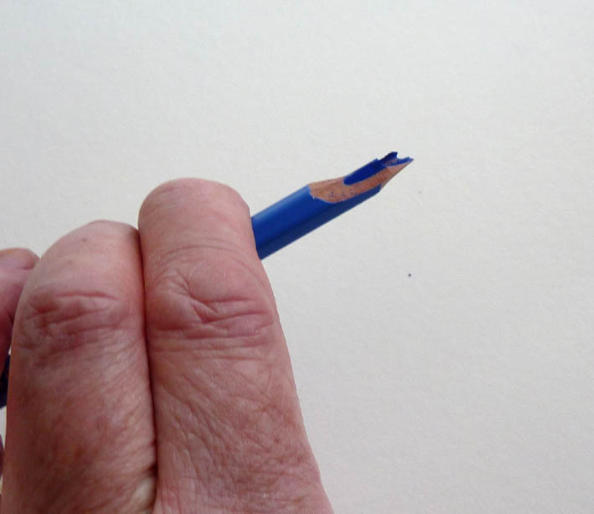
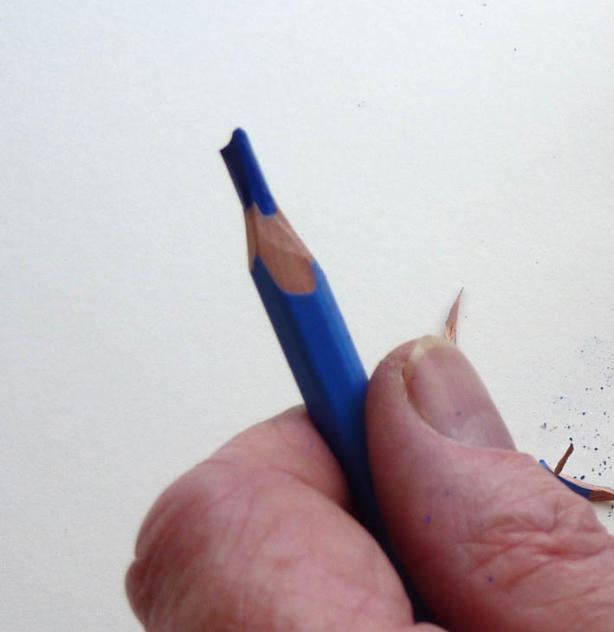
Carry on working round the pencil in this way to leave the original colour strip virtually untouched.If your knife is sharp and you cut with care, you can leave the pigment strip as it was manufactured.
We can then approach sharpening the tip and this - once again - needs care with the knife and control from the thumb.
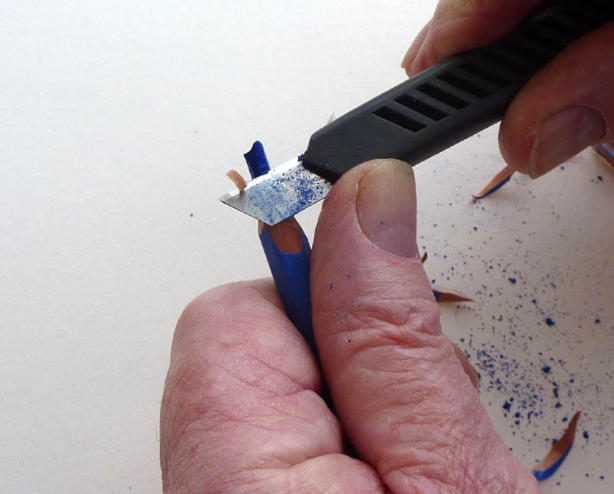
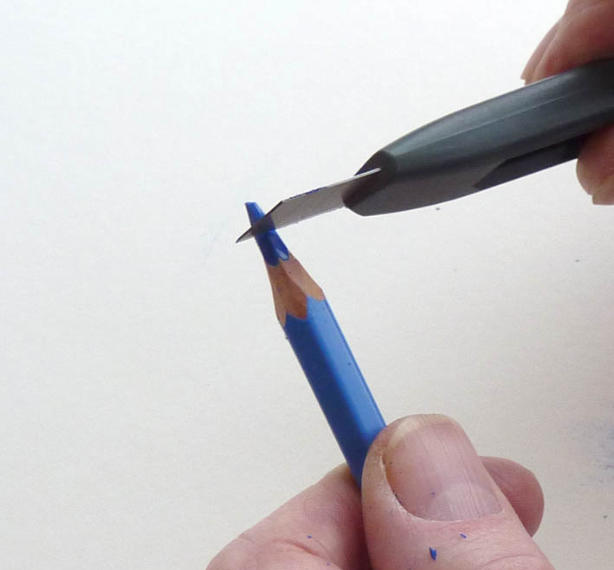


You can take this point as sharp as you need.
If I were sharpening a Staedtler Karat Aquarelle, I would go sharper than this example above, but the Faber Castell Albrecht Durer Aquarelle is a little softer than the Karat and I have left the point with some support from the wood.
I always allow more support for softer pencils, though I like to have a good length of colour showing on aquarelles as I will also be taking pigment off the pencil point with a scrape from a knife and would want to avoid taking wood if I am using the colour to mix a colour wash.
A closer look at sharpeners in detail
Some years ago, I asked members of the UKCPS members Internet Forum for their views on the different brands of sharpeners available. The replies have told me that opinions on sharpeners are as varied as the people commenting!
Over the years I have been as avid a collector of sharpeners as anyone, (A ‘collector’ being defined as anyone who needs ‘one’ and has bought three or more), and I certainly have my favourites and those I would not buy again.
- Home
- Coloured pencil
- Sharpening

